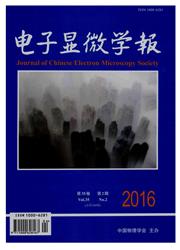

 中文摘要:
中文摘要:
自20世纪30年代(1932年)透射电子显微镜发明以来[1],特别是近二十年来,透射电子显微学技术在以球差矫正技术为代表的空间分辨率[2]、单色光源为代表的能量分辨率、高速CCD相机为代表的时间分辨率[3]等领域都取得了巨大进步,为物理学、化学、生物学、材料科学、电子信息技术等领域的科技进步做出了巨大贡献[4~9]。与此同时,原位外场技术作为透射电子显微学近年的重要发展方向之一[10,11],已经为越来越多的研究领域所关注。透射电子显微学原位外场技术为物理学、化学、生物学、材料科学、电子信息技术等领域的深入科学研究提供了崭新物理图像,为发展新原理、新应用提供了重要机遇。直接在原子点阵尺度研究物质的结构及其演化过程是理解物理、化学和材料科学的重要基础。经过几年的持续努力,作者通过原创性技术发明,解决了一个国际瓶颈性技术难题,即如何在透射电子显微镜中原位变形纳米尺度物体,并对其同时进行双轴大角度倾转,以实现外场作用下原子点阵分辨水平的原位观察。这一技术发明实现了在原子点阵分辨率的原位观察下,对纳米单体材料进行纳米力学及相应结构演化过程间关系的研究。
 英文摘要:
英文摘要:
Since the invention of transmission electron microscopy(TEM) in last century(1932),particularly,the recent two decades,TEM made tremendous progresses in Cs corrected technology for achieving high spatial resolution;in monochromatic electron source for ultra-high energy resolution and fast-CCD camera for timing-resolution.These achievements have contributed enormously to the progresses of the fields of physics,chemistry,biology,materials science,electronics and information science etc.In situ external field technology,as one of the important trends of TEM,has attracted more and more attentions of different research grounds.TEM in situ external field technology provides novel scenarios for physics,chemistry,biology,materials science as well as electronic and information sciences etc.These in situ techniques present important opportunities for developing new mechanisms and novel applications.Directly investigating the structure and its evolution processes at atomic-lattice resolution is the important basis for understanding many mechanisms of physics,chemistry and materials science.In situ deform ation of a nano-object in TEM achieves large angle tilting the specimen along a pair of orthogonal-angled axes for atomic-resolution direct observation.These inventions allow the in situ investigations of the microstructure evolution of the nano-materials with external stress/strain in the atomic-lattice resolution.
 同期刊论文项目
同期刊论文项目
 同项目期刊论文
同项目期刊论文
 Diameter dependence of modulus in zinc oxide nanowires and the effect of loading mode: In situ exper
Diameter dependence of modulus in zinc oxide nanowires and the effect of loading mode: In situ exper Uniform tensile elongation in framed submicron metallic glass specimen in the limit of suppressed sh
Uniform tensile elongation in framed submicron metallic glass specimen in the limit of suppressed sh Defect-dominated diameter dependence of fracture strength in single-crystalline ZnO nanowires: In si
Defect-dominated diameter dependence of fracture strength in single-crystalline ZnO nanowires: In si 期刊信息
期刊信息
